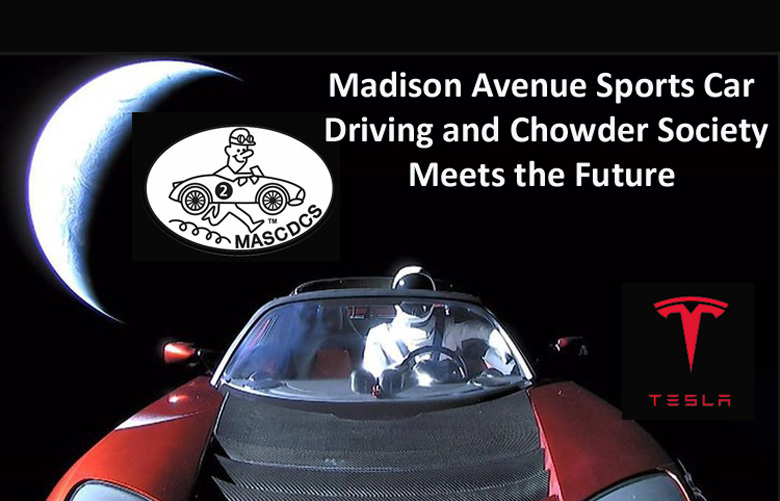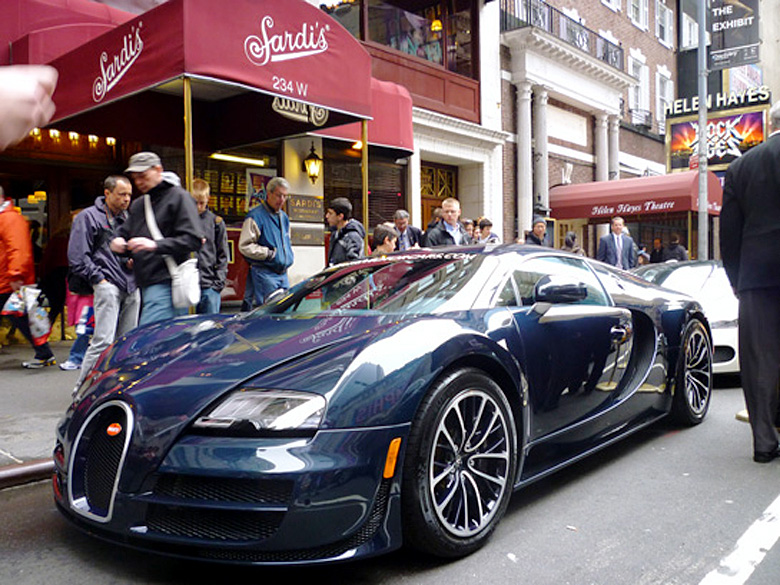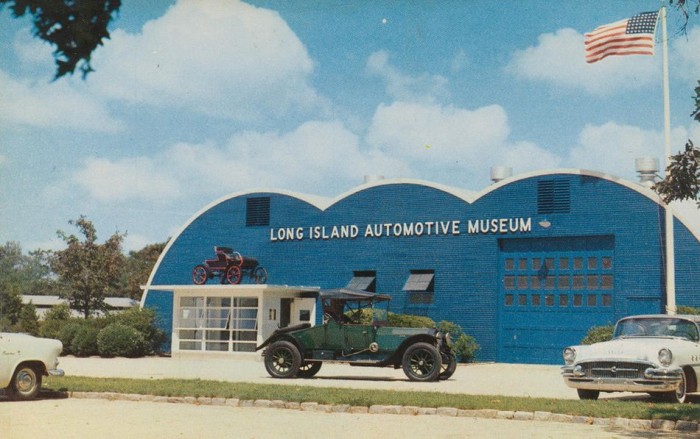Chowder Society Breaks Bread with Tesla: Tradition and Revolution Had a Great First Date
© Philippe H. Defechereux 2018
All photos by P. H. Defechereux except where otherwise noted
From the Archives, February 2018
On the eve of Valentine’s Day, Tuesday, February 13, 2018, there took place a ‘”first date” in Manhattan, NY. between two seemingly improbable parties: the venerable but still vigorous and lively Madison Avenue Sports Car Driving and Chowder Society (M.A.S.C.D.C.S.), turning 61 in March; and Tesla Motors Inc., still wet-behind-the-ears at only 15. Intriguingly, nothing was inappropriate about that pre-Valentine first meet luncheon.
The rendezvous spot chosen was the glass-walled street-level Tesla showroom on West 13th street and 10th Avenue. Everyone and everybody on earth today knows who Tesla is and what they do, besides sending cars in orbit with most powerful rockets. But while the M.A.S.C.D.C.S. continues to be a thriving club with growing membership of car-racing-enthusiasts, not everyone outside the greater New York City metropolitan area has heard of the “Chowder Society,” as long-timers fondly call it for short. So bear with us.
Madison Avenue Sports Car Driving and Chowder Society
Though clearly nothing indeed was legally nor even morally reprehensible about that vast-age-difference luncheon date, observers from the millennial generation could still question it as “weird.” By all appearances, it seemed an obvious clash between the past and the future; between low-tech and hi-tech; and tradition and revolution. On one side of the table: members of a fairly blue-blood Society single-mindedly devoted to a passion for driving vintage and modern cars powered by the internal combustion engine as fast as possible on twisty road circuits; on the other side, a nerd-filled New York management team from a company entirely devoted to ending the existence of the kind of cars the Chowder Society has cherished for so long.
This definitely requires some elucidation. Fortunately, it turns out to be a wonderfully fun story that we thought all car aficionados would relish.
The Madison Avenue Sports Car Driving and Chowder Society was founded almost on a whim in New York in 1957 by Kingsbury E. Moore, a Madison Avenue executive and part time racer, and Art Peck, a CBS News executive who did time as a race commentator for Lime Rock and Nassau. Their irrepressible enthusiasm quickly secured the active backing of Vince Sardi, famous New York restaurateur and himself a racing enthusiast. His storied eatery, naturally called Sardi’s, was and still is situated in New York’s Theater District at 234 West 44th Street, in close proximity to Broadway and Times Square. Vince Sardi was written up in the New York Times as the man who: “ran one of the world’s most famous restaurants, a Broadway institution…” and was “… by wide agreement, the unofficial mayor of Broadway.”
Vince Sardi’s favorite hobby was also cars and racing. A good friend of the founders, he generously offered, at no cost, part of his eatery’s second floor dining room during weekly luncheon hours, whenever members would wish to meet. Renowned author of Sports Cars of the World (1952), cartoonist and illustrator Ralph Stein (1909-1994), himself a great car enthusiast, was asked to design a logo in the spirit of the aborning club, so it could enliven the first luncheon invitation. The talented New York resident accomplished that so splendidly, his original logo remains to this day at the center of the “Chowder Society’s” trademark.
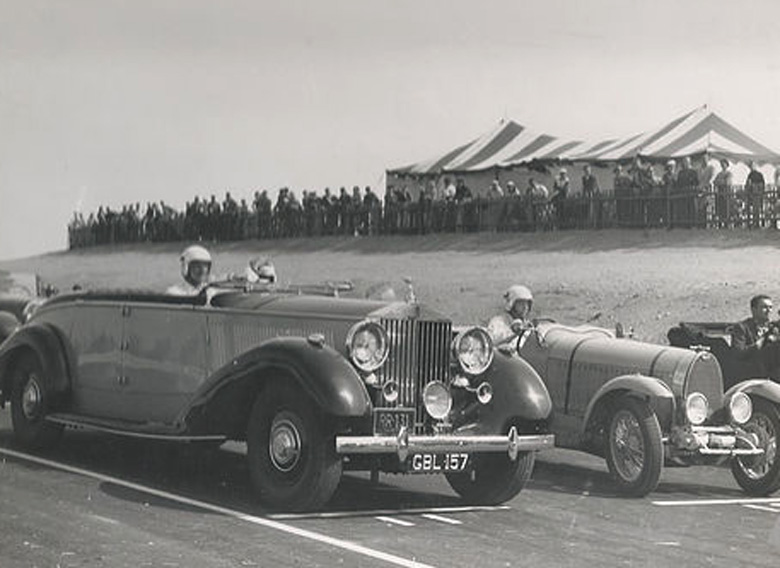
Vince Sardi behind the wheel of “Dragin Wagon” his Rolls Royce PIII, next to a Bugatti. Courtesy M.A.S.C.D.C.S.
In late February of 1957, then, without more official or formal further ado, Moore and Peck mailed some fifty cards in the name of M.A.S.C.D.C.S., inviting people “rumored” to be car and racing enthusiasts to meet for an private luncheon at Sardi’s on March 12, and by personal attendance alone would become members of this new fancy Society, free of charge. The invitation indeed promised that much, though the luncheon had a Prix Fixe of $3.50. Bringing a friend was suggested, so as to increase the odds of a possibly filling two or three tables at Sardi’s.
Amazingly, as the Noon hour approached, Sardi’s seemed as packed with impatient patrons as on opening night for a major new Broadway show! More than 100 would try to make it inside. Only 93 could be seated, the others gracefully turned away. Before the year 1957 was over, M.A.S.C.D.C.S. had improbably become a success, and it still goes on with great fervor to this day, 60 years later, in exactly the same location, the Sardi’s restaurant having been entirely remodeled in 1991 by Vince Sardi himself. While the famed restaurateur passed away in 2007, his establishment remains a New York Theater District landmark to this day, as well as M.A.S.C.D.C.S.’s unofficial but sacred “World Headquarters.”
________________________________________________________________
Please subscribe to VeloceToday! Click here..it’s easy!
________________________________________________________________
Enter Austin Clark
Among the early members was Henry Austin Clark, Jr. (1917-1991) a car collector who established the Long Island Automotive Museum. “Austie was born so rich, he never had to work a day in his life.” But he was well-liked and shared a deep passion for racing, serving as the vice president of the Bridgehampton race track. Early in 1962, to commemorate the fifth anniversary of M.A.S.C.D.C.S. he crafted an article for Automobile Quarterly ( V1-2) about the Society, conveying how memorable the early years were, how much fun it was.
Austin Clark explained, “The time-honored chowder-and marching societies were made up of people who enjoyed a good time at seaside get-togethers over cauldrons of steaming chowder and mugs of friendly, frothy beer.” Peck and Moore now wanted to tie that tradition to one of the new post-WWII passions that were spreading through the land: Road racing and the fun of driving fast, nimble cars safely at maximum speed on challenging road circuits.
Clark added: “[Members] may be in radio, television, advertising, show business, newspapers or magazines, imported or domestic or automobiles. … the M.A.S.C.D.C.S. has a connotation of friendly conviviality, unsullied for the most part by materialistic aims or charitable excuses for its existence. Those who come to the meetings do so for fun and companionship and have no particular ax to grind.”
The society thrived, with new generations replacing the aging founders, but remained fully faithful to the original spirit while seeing the day of the MG TC evolve into the era of the latest Bugatti Veyron. This goes on better than ever in 2018, and the pre-Valentine Day Tesla luncheon plainly testifies to this amazing mix of untouchable traditions and on-going bold moves into the future, including a luncheon at the new Tesla New York Headquarters.
Chowderheads and Space Nerds

The Tesla New York dealership which opened for business on December 16, 2017 – A clean, light design appropriately “reaching for the stars.”
Everything about Tesla is new, fresh and avant-garde, in contrast with Sardi’s and the Chowder Society. However, with both hosts and guests sharing the same passion and enthusiastic spirit about automobiles, the bond took instantly, once the first group of Chowderheads arrived. This deep and century-old affinity among all enthusiasts only solidified as our two-hour lunch continued its adventurous course.

An unusually quiet group of Chowderheads listening attentively to the Tesla presentation, before the test drive. Almost “standing room only,” just like at Sardi’s before the grand opening of a highly-anticipated Broadway play.
The new, naturally-lit Tesla showroom is at street level; a large garage in the back held the cars that each attending Society member would get to test drive after the luncheon. No Model 3 would be available but that was to no one’s surprise. We all knew the newest Tesla model is in very short supply. Vince Sardi during his lifetime actually helped put a few actor stars in orbit due to his deep involvement with Broadway shows, but even he could never have imagined, let alone achieved, what Elon Musk and Tesla accomplished this past January.

Tesla New York Showroom entrance, which early “Chowderheads” registering. The lady in the white sweater by the front desk is Mary Wennerstrom, Chairwoman of the Chowder Society.
Within the Tesla premises, it quickly became clear that few if any Chowderheads, anticipating the first Tesla drive of their life, would mind being handed a Model S family sedan, or the Model X “falcon-wing” SUV. This author, though not at all a spring chicken, but definitely a moderniste, could sense the anticipation, even before the first munch of the excellent Dean & De Luca-prepared meal could be taken. He could also detect that a few old-timers could not wait to acquire a real all-electric car experience (perhaps to better to disparage the newfangled technology he or she did not grow up with.)
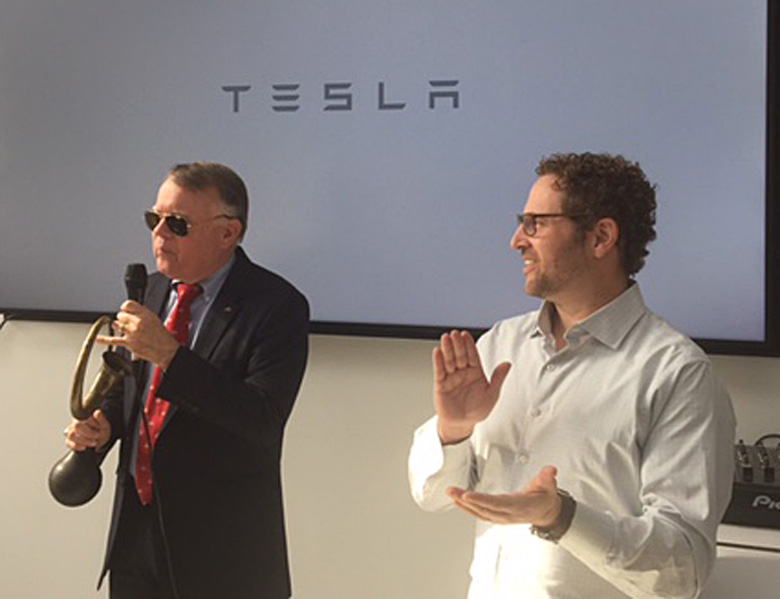
James P. Donick, Board Member and Luncheon Spokesman of the Chowder Society opening up the ceremonies. Next to him is our official Tesla host, Jeremy Snyder.
As per tradition at every Chowder luncheon meeting since 1957, no food was served before the official M.A.S.C.D.C.S speaker Jim Donick could welcome everyone, make a few newsworthy announcements, then honor the main speaker, in this case from Tesla. Standing beside Donick was Jeremy Snyder, our host, a Tesla NY manager and eight-year company employee, therefore a true veteran of the “space crew.”
Tesla’s strategy for the future of the automobile
When Jeremy started expounding on the Tesla car company’s achievements and plans, the now-munching Chowder members sat quietly, a sure sign of pent-up excitement at both the Tesla revelations and the forthcoming test drive. Though Musk is well-known for his over-optimism about future accomplishments, the spectacular simultaneous landing of two recyclable booster rockets on sea platforms just two weeks earlier gave Jeremy’s Tesla Motors projections a lot of credibility.

Jeremy Snyder of Tesla, giving a passionate and fascinating presentation of Tesla Motors’ current status and medium term plans. Despite in-going skepticism among several members, the majority were impressed.
So the anticipation was great, and we were not let down. Especially when Jeremy explained quite vividly with charts and numbers, that Elon Musk looked from his starting gate a decade ago at all-electric cars not as just an alternate, cleaner form of motorization, but as a new, fully-integrated infrastructure for pollution-free driving, It included all three key, highly challenging but essential component parts only a visionary could foresee:
• Giant battery factories that can mass produce powerful low-cost batteries (“the new fuel”). Batteries are not only the fuel of the new car, but also its most significant single cost item.
• A new species of automobiles that, under a skin and shape reasonably familiar to all, feature completely new structural designs that will handle the road and accommodate passengers splendidly with added safety, and with zero emissions. This is made possible by the much less complex and smaller electric motor set-up, while allowing deeper and safer front and rear “crumple zones” than traditional automobiles. Each Tesla vehicle, of course, also includes the latest electronic package modern technology will allow. And it can be upgraded every few weeks by Wi-Fi while you sleep quietly at night.
• An extensive new network of electric charging stations, both along all major roads and in-home, to make “range anxiety” as irrelevant as it is today with gas-powered cars. The regional, national and world-wide charts we saw, showing both current, near-future and 2025 Tesla coverage in three different colors, were indeed both impressive and reassuring. Even allowing for “Muskian over-optimism,” this author is convinced Tesla is ten years ahead of its European competitors, and probably at least five years of their Asian counterparts. If Tesla’s Model 3, with an entry price of $35,000 and currently in its build-up year, manages to overcome its teething problems and reach at least 200,000 units produced in 2018, Tesla has will have made it as the newest member of the “big global car manufacturer league,” but also its most futuristic.
Driving the Tesla Model S
So, what about the test drive– mine was a white Tesla Model S P100. Despite the limited time each Chowderhead had at the wheel, and the challenge of the lower Manhattan West Side Parkway traffic, it was enough to get a very good feel for the Tesla experience. This nearly 5,000 pound car– four-wheel-drive, two electric motors – looks very good; its interior is neatly modern and totally comfortable.

The Tesla showroom entrance at the corner of 850 Washington Street and West 13th Street. Large windows for maximum natural lighting.
The big square digital screen in the center of the dashboard still appears a little bit awkward to me, but so did my first PC screen when I moved up from typewriter to personal computer. In fact my first Tesla drive reminded me of that “first experience of the coming future” decades ago, when I beheld the first Apple Macintosh, and bought it instantly.
When I was handed the steering wheel, the car also held a Tesla staff member and two other Chowderheads; we were near full-load. The downtown segment of the West Side Parkway is very wide and straight – six generous lanes – though cluttered with reasonably synchronized stoplights every three blocks or so. This gives one a great “airstrip” opportunity to test accelerations from a standing start over and over.
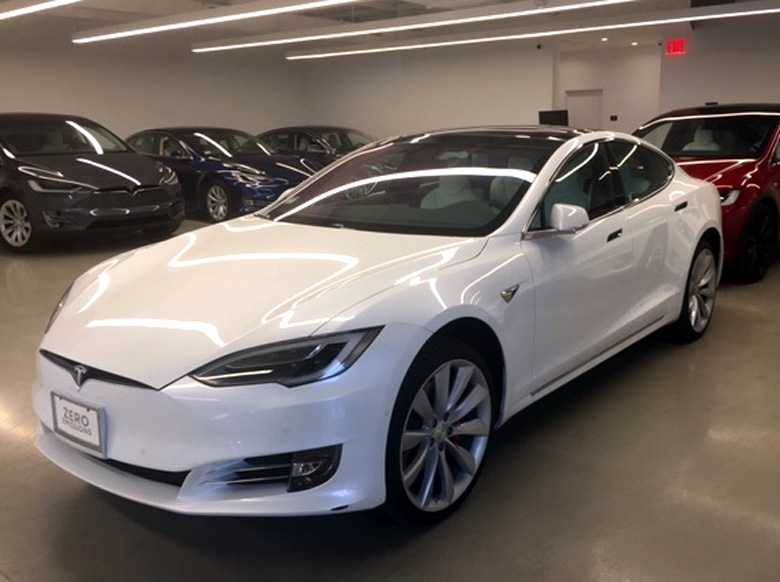
The actual white Tesla Model S P100 this author found himself thrilled to drive, weaving and punch-accelerating safely and with surprising ease through Manhattan West Side Parkway traffic.
Even though when I drove it only for some 10 minutes, those accelerations felt truly phenomenal. Every time. Having long lived and driven in and around Manhattan for many years, I’m quite used to weaving from lane to lane left and right, between stoplights and through yellow lights. The Model S performed admirably, and felt so light in doing so, it was hard to reconcile this amazing agility with its actual weight.
The car magazines and official road tests I had read beforehand, with a jaundiced eye, were surprisingly correct. And going from a standing start to 60 mph in 2.3 seconds, through three green stoplights ahead before hitting a red one – roughly a quarter mile, in a five passenger sedan holding four people, is quite extra-terrestrial. So after I reluctantly had to hand the wheel over to a fellow Chowderhead, and with all the background described above, there is no doubt left in my mind Tesla represents the future. This, from a passionate driver of sporty internal combustion engine cars for decades.
The author would like to acknowledge the help provided by the following fellow Chowderheads and friends for key highlights and historical photos: Mary Wennerstrom, James P. Donick, Joel Levin and Jan Hyde.
Comments from February 2018
From Philippe Defechereux
“Old Jim” is alive and well! O My! Long time, no chat my longtime friend and early American racing historian mentor. I’ll try to find out whether anybody remembers Diana Bartley. I doubt it; that generation has passed away – except you and your young wife ;). Great photos supplied by the new management, though. Check the website.
Bruce Wennerstrom, who took over the MASCDCS in 1971 and did a great job keeping it alive and well for nearly 30 years, passed away in December of 2015. After some scary moments, two of his able children, and a bunch of senior members, took the new lead the Chowder Society, with the goal of rejuvenating it and expanding it – Bruce in his last few years had devoted more time to the successful Greenwich Concours he and his wife Genia created together back in the late 1990s.
So now, Mary Wennerstrom is Chairwoman, and doing a great job. The Tesla visit is testimony to her new vision. Get my email from Pete, and write me an update. I’d be delighted.
From Jim Sitz
Had the good fortune to attend their 2nd or 3rd
lunch which was in 1957. I was on way to Europe
to take in the race season and all those Chowderheads
gave me some razing about that!
I was invited by Diana Bartley who was editor of
Auto Age magazine–does anybody out there remember her?
Jim Sitz
